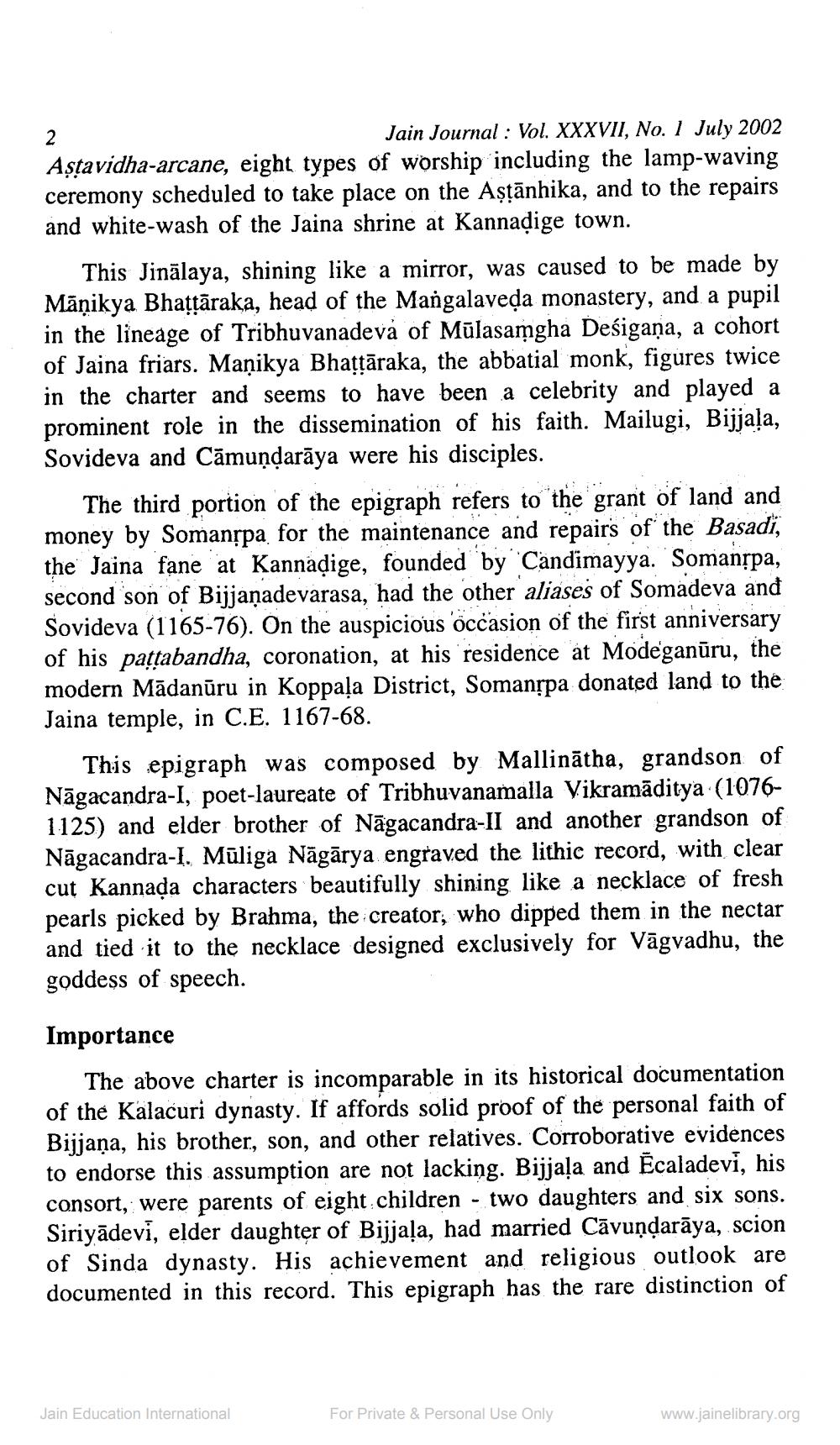Book Title: Jain Journal 2002 07 Author(s): Jain Bhawan Publication Publisher: Jain Bhawan Publication View full book textPage 8
________________ Jain Journal: Vol. XXXVII, No. 1 July 2002 Aṣṭavidha-arcane, eight types of worship including the lamp-waving ceremony scheduled to take place on the Aṣṭānhika, and to the repairs and white-wash of the Jaina shrine at Kannadige town. 2 This Jinälaya, shining like a mirror, was caused to be made by Manikya Bhaṭṭāraka, head of the Mangalaveḍa monastery, and a pupil in the lineage of Tribhuvanadeva of Mulasamgha Deśigana, a cohort of Jaina friars. Manikya Bhaṭṭāraka, the abbatial monk, figures twice in the charter and seems to have been a celebrity and played a prominent role in the dissemination of his faith. Mailugi, Bijjala, Sovideva and Camuṇḍaraya were his disciples. The third portion of the epigraph refers to the grant of land and money by Somanṛpa for the maintenance and repairs of the Basadi, the Jaina fane at Kannadige, founded by Candimayya. Somanṛpa, second son of Bijjaṇadevarasa, had the other aliases of Somadeva and Sovideva (1165-76). On the auspicious occasion of the first anniversary of his pattabandha, coronation, at his residence at Modeganūru, the modern Mādanūru in Koppala District, Somanṛpa donated land to the Jaina temple, in C.E. 1167-68. This epigraph was composed by Mallinatha, grandson of Nāgacandra-I, poet-laureate of Tribhuvanamalla Vikramaditya (10761125) and elder brother of Nagacandra-II and another grandson of Nāgacandra-I. Muliga Nāgārya engraved the lithic record, with clear cut Kannada characters beautifully shining like a necklace of fresh pearls picked by Brahma, the creator, who dipped them in the nectar and tied it to the necklace designed exclusively for Vagvadhu, the goddess of speech. Importance The above charter is incomparable in its historical documentation of the Kalacuri dynasty. If affords solid proof of the personal faith of Bijjana, his brother, son, and other relatives. Corroborative evidences to endorse this assumption are not lacking. Bijjala and Ēcaladevi, his consort, were parents of eight children two daughters and six sons. Siriyādevi, elder daughter of Bijjala, had married Cavuṇḍarāya, scion of Sinda dynasty. His achievement and religious outlook are documented in this record. This epigraph has the rare distinction of Jain Education International - For Private & Personal Use Only www.jainelibrary.orgPage Navigation
1 ... 6 7 8 9 10 11 12 13 14 15 16 17 18 19 20 21 22 23 24 25 26 27 28 29 30 31 32 33 34 35 36 37 38 39 40 41 42 43 44 45 46 47 48 49 50 51 52 53 54 55 56 57 58 59 60 61
